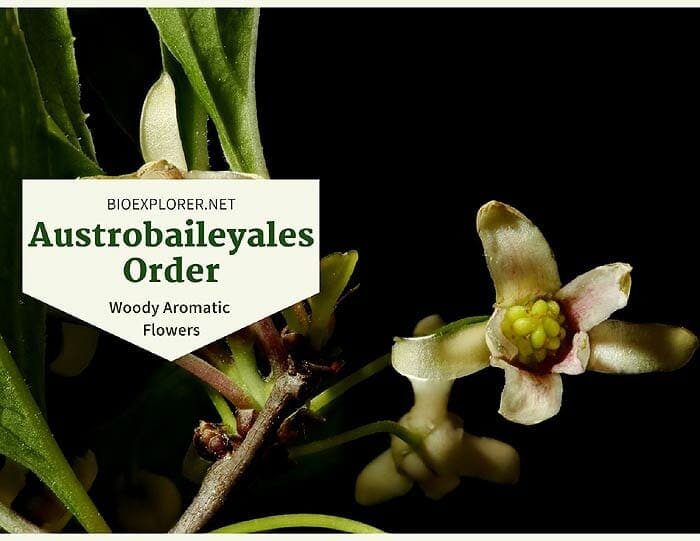
Austrobaileyales is the flowering plant order comprising 3 families, 5 genera, and 100 species[1] of woody plants growing as shrubs, trees, and lianas. This order has its place in basal angiosperms, the ANA grade (Amborellales, Nymphaeales, and Austrabaileyales).
The Order Austrobaileyales includes three families. The Austrobaileyaceae with only one genus, the Schisandraceae (3 genera) and the Trimeniaceae (1 genus).
Table of Contents
Austrobaileyales Pronunciation
Austrobaileyales Distribution
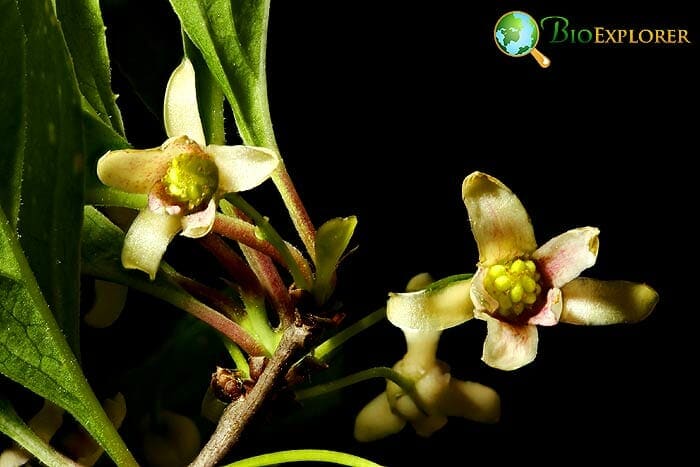
Family Schisandraceae are woody plants distributed in tropical to temperate regions of East and Southeast Asia and the Caribbean.
- The woody plants of the family Trimeniaceae are found in Eastern Australia, subtropical to tropical Southeast Asia, and the Pacific Islands. The one species of woody vines from the family Austrobaileyaceae is thriving in Australia.
- This Austrobaileyaceae species[2] can occur in both lowland and higher altitude rainforest of wet tropics as a canopy vine thriving to the top part of the tree.
![]()
Austrobaileyales characteristics
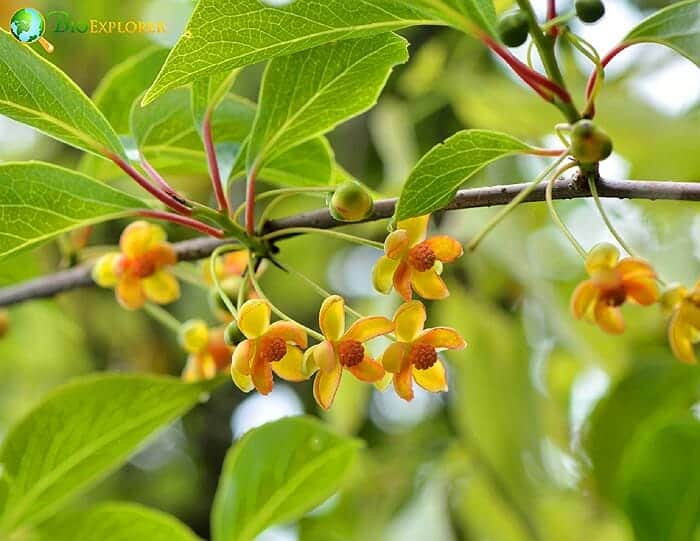
Species under order Austrobaileyales have the following characteristics:
- Members of Austrabaileyales are woody plants with water-conducting cells considered intermediate between tracheids and true vessels. Members can be trees, shrubs, or lianas.
- The leaves are simple, opposite or alternate, aromatic, and petiolate. The stipules are absent (exstipulate).
- Laterocyric stomata are typical in this flower order. In Austrobaileyaceae and Schisandraceae, the cuticle surface is radiate-striated around the leaf blade’s lower surface cells.
- Flowers are hypogynous, small or large, generally solitary in terminal or axillary leaves on ultimate branches.
- The floral 0rgans are spirally arranged, and the perianth segments do not form distinct sepals and petals.
- The ovary is superior, and carpels are free or fused.
- Flowers can be unisexual or bisexual. The fruits are an aggregate of berries having one to five seeds each.
- The embryo is straight or round and shapeless.
![]()
Austrobaileyales Flowers and Reproduction
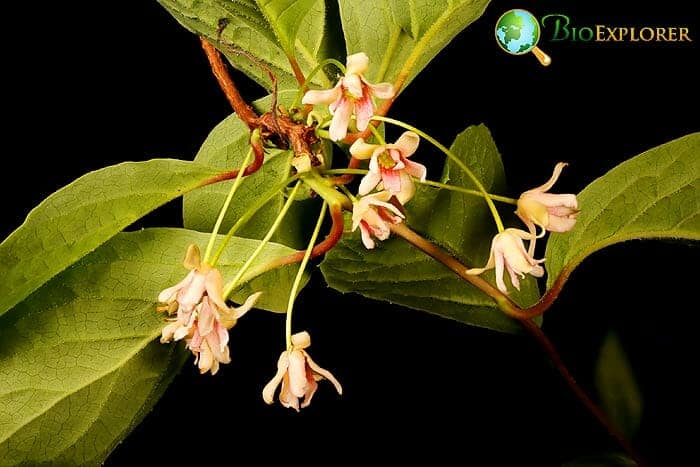
The flowers of Austrobaileyaceae are large and pendulous. The petals are spreading, and stamens are many with broad filaments and internal staminodes.
- They are bisexual with greenish to yellowish coloration with brown spots. The flowers of Trimeniaceae are small and whitish. Inflorescences in terminal or axillary panicles or branched racemes.
- It usually has 6 perianth segments and 6-15 stamens. Schisandraceae flowers are small, usually fragrant, and can be solitary or aggregated in inflorescences. Inflorescences can be axillary and occasionally cauliflorous.
- Schisandra chinensis has fragrant and flowers in pink or white. The fruits are also attractive in colors.
- Schisandraceae are radially symmetrical and lack differentiation between sepals and petals. Gall midges help in the pollination of this family of flowers. Beetle-pollination of Schisandraceae is also common.
- Pollination of Austrabaileyaceae is also through insects. The A. scandens’ flower releases a smell of rotting fish, attracting flies to pollinate. The tiny flowers of Trimeniaceae are both pollinated by insects and wind.
- Some of the insects involved in the Trimeniaceae pollination[3] are hover-flies, sawflies, and bees. The presence of pollen traps indicates wind pollination permission, wherein the pollen is shed directly into the air.
![]()
Austrobaileyales Family differences
Schisandraceae Family
- Leaves are alternate; the leaves are single at each node and borne along the stem alternately in an ascending spiral.
- Flowers are small.
- Flowers are unisexual.
- The perianth-segments are few to many (5-24), and stamens are few to numerous (4-50, rarely 80).
- The carpels are numerous[4] (12-100) free conduplicate and spirally arranged around the receptacle.
- The fruit is typically 1-5 seeded.
- The embryo is straight.
![]()
Austrabaileyaceae Family
- The leaves are opposite; the leaves are paired at a node and borne opposite to each other.
- Flowers are large.
- Flowers are bisexual.
- There are 8-9 carpels; free.
- Each flower has 10-15 greenish perianth parts and 12-25 petal-like stamens.
- The seeds are 3-4 per fruit.
- The embryo is round or shapelessAustro.
![]()
Trimeniaceae Family
- The leaves are opposite; the leaves are paired at a node and borne opposite to each other.
- Flowers are small.
- Male and female flowers occur on the same plant, separate plants, or with all the flowers bisexual.
- Carpels are 1-2; fused.
- Each flower usually has 6 perianth segments and 6-15 stamens.
- Seed is 1 per fruit.
- The embryo is straight.
![]()
Austrobaileyales Example species
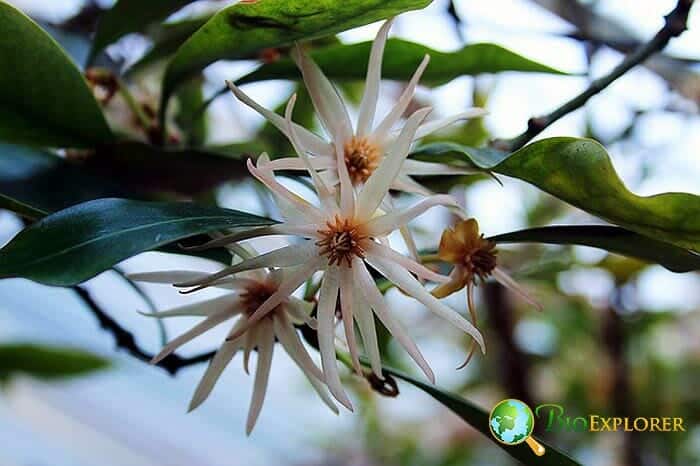
Some of the benefits from the members of Austrobaileyales involve usage in flavoring and perfumes (Illicium verum). Some are also used as herbal medicine (Schisandra chinensis[5] ); Others are commonly grown in the garden as ornamentals. The plants below are examples of members under Austrobaileyales.
- Wu Wei Zi
- Magnolia vine
- Star anise
- Bay starvine
- Kadsura vine
- Bitter vine
- Trimenia weinmanniaefolia
- Trimenia macrura
- Trimenia neocaledonica
- Austrobaileya scandens
![]()











